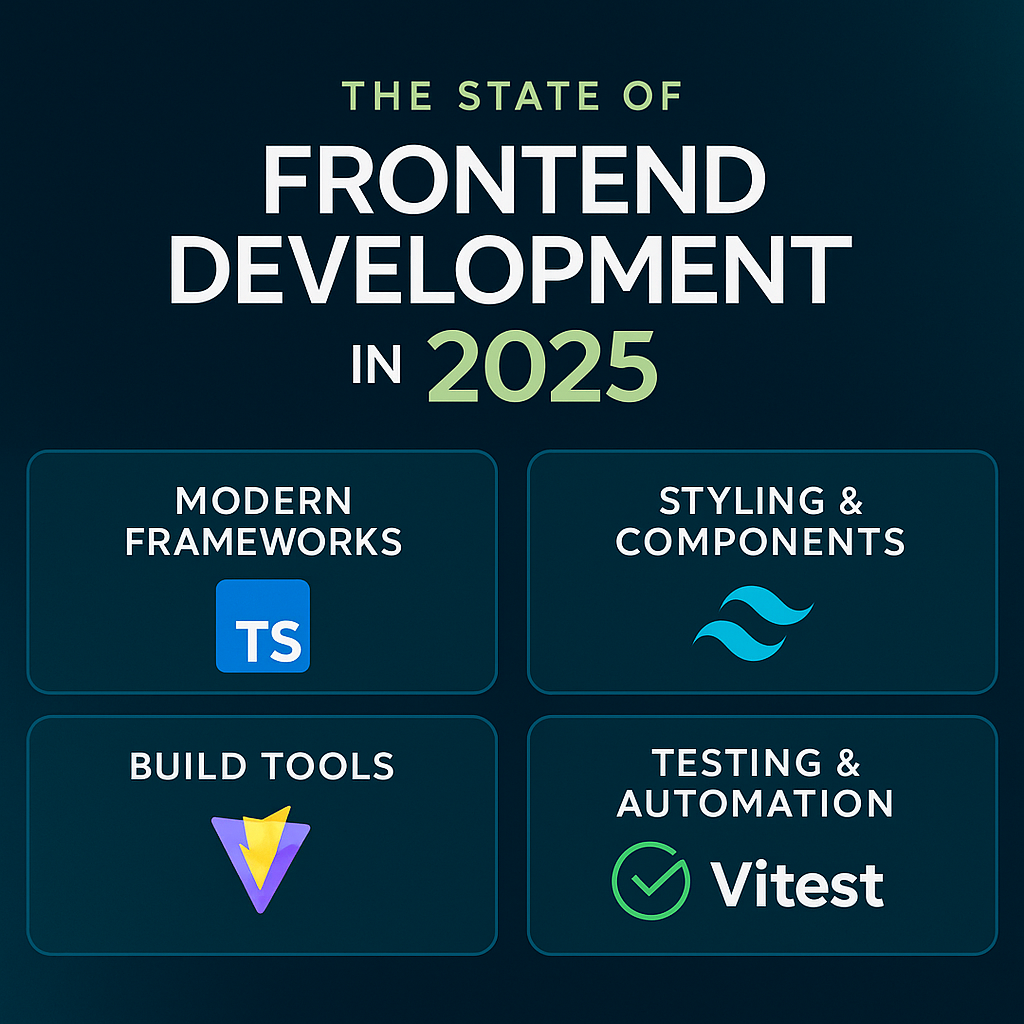Frontend Development in 2025

The State of Frontend Development in 2025
Frontend development in 2025 blends performance, accessibility, and rapid iteration, powered by automation and AI. Developers no longer build just static interfaces. Instead, they design responsive, scalable experiences that work across devices, adapt to user context, and integrate deeply with backend systems. As web standards evolve and user expectations rise, staying competitive means adopting tools, frameworks, and practices that deliver fast, secure, and maintainable frontends.
Modern Frameworks and Language Trends
JavaScript still underpins frontend development, but
TypeScript has become the standard. Its use across major frameworks enhances robustness, supports static analysis, and improves team collaboration.
React 19 remains the leading component library, introducing Server Components and enhanced Concurrent Rendering. Meanwhile,
SvelteKit and
Qwik focus on speed and minimal JavaScript delivery, using techniques like resumability and fine-grained hydration to challenge traditional rendering models.
Styling and Component Design
In 2025, styling emphasizes scalability and themeability.
Tailwind CSS 4.0 adds design token support and dark mode features, making it ideal for startups and large design systems alike. More developers are using CSS-in-TypeScript solutions like
Vanilla Extract for typed styling workflows. Reusable UI libraries such as
shadcn/ui,
Radix UI, and
Chakra UI offer accessible components that are easy to theme and extend.
Build Tools and Optimization
Tooling has advanced rapidly.
Vite leads in local development with instant hot module replacement and zero-config setup. For production,
Turbopack—Webpack’s successor—offers fast, incremental builds and integrates closely with
Next.js. These tools enable teams to deploy scalable, serverless apps with short build times and excellent cold-start performance, especially when combined with edge rendering on modern hosting platforms.
Testing, Quality Assurance, and Automation
Testing is now more integrated and efficient.
Vitest supports fast unit testing and mocks, complementing Vite.
Playwright excels in end-to-end testing with its cross-browser support and strong debugging tools. Moreover, visual regression and accessibility testing are now standard in CI/CD pipelines. AI-driven QA tools also detect layout issues, keyboard traps, and performance flaws before deployment. These enhancements ensure stable, accessible apps with consistent user experiences.
Accessibility and Internationalization
Accessibility is a baseline expectation, not a bonus. Developers follow
WCAG 2.2 guidelines and use tools like
axe-core and browser audits to catch issues early. QA processes now include keyboard support, focus management, and screen reader compatibility. For internationalization, frameworks like
next-intl and
LinguiJS help build multilingual apps with region-specific routing, localized content, and proper formatting.
Performance and Security Standards
Core Web Vitals still define performance health, especially with Google’s search rankings in mind. Developers improve metrics like INP, LCP, and CLS using best practices: lazy loading, edge caching, font optimization, and CDN-backed delivery. On the security front, apps enforce strict
Content Security Policies (CSPs), use HTTPS by default, and rely on secure components. Hosting platforms now include built-in defenses against
XSS,
CSRF, and injection attacks.
AI-Enhanced Development Workflows
AI acts as a powerful, behind-the-scenes assistant. Tools like
GitHub Copilot and
Cody help developers write code, fix bugs, and catch logic errors in real time. Platforms such as
Locofy,
Vercel v0, and
Builder.io turn Figma designs into semantic HTML or React components. This design-to-code automation saves time and bridges the gap between design and development.
The Skills That Define a Modern Frontend Developer
Today’s frontend developer wears many hats: designer, performance engineer, and product strategist. They must master JavaScript and TypeScript, understand component lifecycles, handle async data flows, and work with browser APIs. However, soft skills matter just as much. Collaboration with designers, PMs, and backend teams is essential. Developers now contribute to component libraries, shape UX, and make architecture decisions that affect scalability.
As frontend and full-stack roles continue to merge, developers who prioritize accessibility, testing, security, and performance will lead the next wave of user-focused digital experiences.